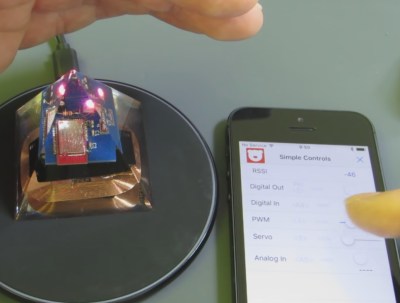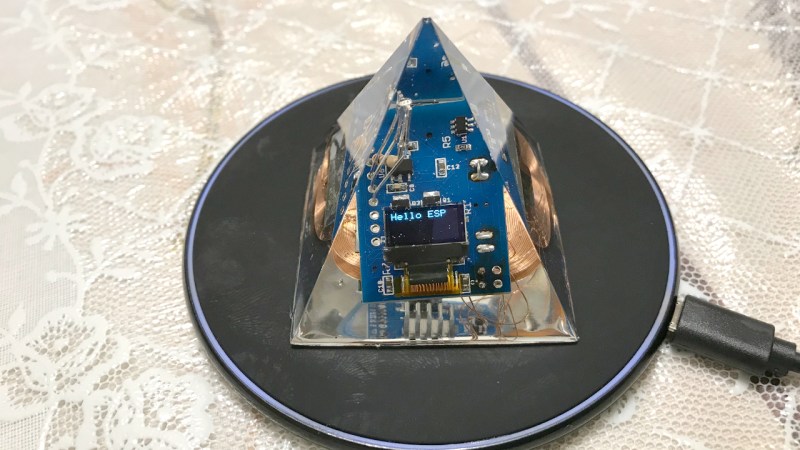We sometimes get our inspirations from art. When [kodera2t] saw some Japanese art of fish drawings embedded in clear epoxy he just had to make his own. But while skilled in electronics, he wasn’t skilled at drawing. We’d still call him an artist, though, after seeing what he came up with in his electronics embedded in crystal clear epoxy.
 His first works of electronic art were a couple of transistors and some ICs, including an 80386, encased in epoxy. But then he realized that he wanted the electronics to do something interesting. However, once encased in epoxy, how do you keep the electronics powered forever?
His first works of electronic art were a couple of transistors and some ICs, including an 80386, encased in epoxy. But then he realized that he wanted the electronics to do something interesting. However, once encased in epoxy, how do you keep the electronics powered forever?
He tried a solar cell charging a battery which then powered an LED but he didn’t like the idea of chemical batteries encased in epoxy for a long time.
He then switched to wireless power transmission with a receiving coil in the base of epoxy pyramids. For one of them, the coil powers a BLE board with an attached LED which he can control from his phone. And his latest contains an ESP32-PICO with an OLED display. The code allows him to upload new firmware over the air but on his Hackaday.io page, he shows the difference between code which can brick the ESP32 versus code which won’t. But don’t take our word for it. Check out the video below to see his artistry for yourself.
While embedding electronics in epoxy is new to [kodera2t], we’ve seen it a few times before. once in the form of an amplifier circuit done beautifully, dead bug style, and a more experimental attempt with a solar lantern.
















…did a simple 9v flip-flop led flasher in epoxy in 1987 – Lathed it up and then buffered it to a real smooth finish. Was a cool school project being the ripe age of 13.
Please what epoxy resin? How do you make do clear with no bubbles? Vacuum? Thanks. Very beautiful.
those are exactly the questions I had, these are perfectly clear, what is his secret. Vacuum? Heavy vibrating table to shake the bubbles out, super-duper-smooth-resin perhaps. Oh… and of course, what did it cost… the resin?
He probably used a product like EasyCast, which is formulated to do this sort of project without power tools. An 8 oz kit (about 250 ml) runs USD$15 or so at the hobby store.
He shows the box for the epoxy product in his build instructions: https://hackaday.io/project/160795/instructions The writing on it is mostly Japanese and the only English says “NEO”. I don’t recall seeing any details on how he removed bubbles.
To eliminate the bubbles, you use a wood stirrer to remove them. You then carefully & slowly poor the resin into the mold.
No idea how he did it but a few common techniques can get you bubble free results.Vacuum the mix after casting, like you said, careful mixing so you don’t introduce bubbles, use a thin mix so bubbles have time to migrate out before it sets, and pour the epoxy in a thin stream rather than big globs.
there’s probably some post-processing involved too..
You can vacuum the epoxy after mixing to get rid of a lot of the mixed in air, after embedding the electronics let it harden under pressure to compress the remaining bubbles.
smoothon makes a very cool soft resin with good optical properties that is easily removable. its meant to simulate ice, for displays. I have used it to encapsulate all kinds of stuff for displays. its also recycleable by breaking it up and using it with fresh resin. as a filler.
semms like it would be great for elevtronics too. so you could remove it and fix the hardware inside if needed.
https://www.smooth-on.com/tutorials/realistic-ice-display-encapso/
How does this material do with heat displacement? Are there any concerns in comparison to open air or does this act as a giant heatsink for the boards?
No, it is not good for heat displacement and things entombed in it are hard to repair and repairs are definitely not pretty. That being said though, people have been canning and potting circuits for a long time, though they may have been using the mil or commercial versions of the parts. I recall back in the mid 80’s dissecting and reverse engineering potted modules that dated back to the early 70’s. And for many many years nvram and rtc’s had lithium cells potted in with them. The hacks back in the day involved clever use of a grinder and a dremel tool to get at the straps going from the battery on top to the chip underneath so you could fire up the nv ram or rtc with AA cells or what have you. And for while there were the potted videocipher modules in the C band satellite receivers. You still occasionally run across potted modules today, though they seem to be on the wain.
a dead-bug soldering style circuit would look very nice encased like this..
https://hackaday.com/2012/04/13/free-formed-circuit-protected-by-a-brick-of-crystal-clear-resin/ f’rinstance.
very nice!
Has anyone made a lens from resin? What is the Refractive Index like?
Cool. He built a sith holocron.
Potentially reinventing the deck prism as well. Solar cells will also charge caps as well, no need for a battery
That’s pretty brave with the OTA updates. Maybe ESP32 is better in this regard, but in my experience OTA updates on ESP8266 were anything but reliable.
I guess that’s part of why he’s using his phone, bluetooth in the ESP32 might be slightly more reliable than the ESP8266’s wifi.
It isn’t wifi that tends to cause OTA problems for me, it’s just that esp8266 can’t do the same thing the same way twice in a row. If you tested something and it worked 5 times, it does not mean that it will not fail on 6th. For example, libesphttpd has an interesting WiFi configuration bit, which for some reason resets the chip in the process of switching modes. It seems to do that intentionally, even though I really do not understand the reason for resetting. Anyway, 2 out of 3 times the reset procedure will get stuck at boot. I had similar experiences with various OTA setups. For OTA, I managed to come up with something mostly workable using rboot, but I don’t trust it even though I have full access to my device and can unbrick it at any moment. I would be very nervous OTA-updating an epoxy-sealed esp8266.
only use codes provided officially by Espressif to avoid the problem.
Maybe if Espressif provided any real “codes” there wouldn’t be “the problem” in the first place. Your company gives away random disjointed bits of information and dysfunctional pieces of untested code and forum support is just a farce.
Some priceless lines from Espressif-provided spi slave driver:
Helpful comment:
This one shows the confidence the author of this code has in what they’re doing:
Sample communication between users and Espressif:
Question:
Answer:
This goes on forever. I really want to like this chip, but it’s been nothing but hours, days, weeks of frustration.
I recall ads for jewelry made of early LEDs in epoxy or polyester resin in sci fi magazines in the ’70s. Power source was external, of course. Wires in the necklace chains, I think.
I thought that potting radio circuits might just brick them on their own?
Also what’s so dangerous about the battery??